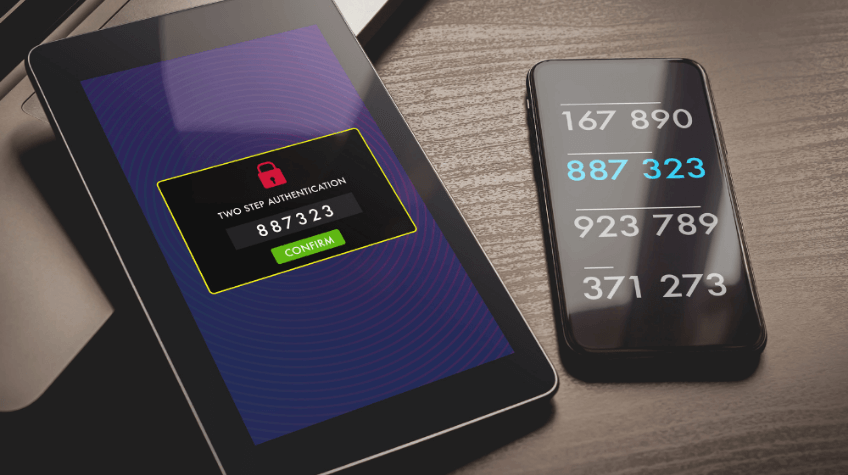
In this post, we shall discuss everything about two-factor authentication, including how does two-factor authentication work.
Let us take a look at the article…
Table of Contents
- What is two-factor authentication?
- Why do you need Two-Factor Authentication?
- Different Types of Two-Factor Authentications
- How does two-factor authentication work?
- Is two-factor authentication secure to use?
- Don’ts of Two-Factor Authentication
What is two-factor authentication?
Two-factor authentication or 2FA, also known as dual-factor authentication or two-step verification, is a security method in which users verify their identity using two independent authentication factors. It adds an extra layer of security to the authentication process by making it arduous for attackers to get access to a person’s devices or online accounts.
2FA is used to safeguard users’ credentials as well as the resources they have access to. Two-factor authentication is generally required to have a higher level of security because Single-factor authentication (SFA), in which the user gives only one factor (usually a password or passcode), provides a lower level of protection. In contrast, two-factor authentication relies on a user supplying a password as the first factor and a second separate element (commonly a security code or a biometric factor) as the second factor.
Why do you need Two-Factor Authentication?
Two-factor authentication is a strategy rather than a solution. You can use it in a variety of ways to protect your devices and online accounts. Online service providers increasingly utilize two-factor authentication (2FA) to secure their users’ credentials from hackers or cyber-criminals who steal password databases or obtain user passwords through phishing efforts.
Different Types of Two-Factor Authentications
Two-factor authentication can be divided into three categories:
1. Two-Factor Authentication via Text Message
Two-factor authentication via text messaging is quite popular amongst users. When you use 2FA-enabled login processes, you’ll first input your username and password on the computer and then receive a text message with a verification code on your phone. To finish the login process, you must input the verification code on the computer.
This is the basic version of two-factor authentication because it needs only a mobile phone and a wireless internet connection. In this method, you get a text message along with a code that you use to authenticate yourself.
Although 2FA is widely used for personal accounts, it is still not completely secure. Attackers may impersonate you to the phone provider and obtain access to your accounts without your knowledge. Well, this solution is not so good for big organizations and corporations as it’s not considered secure for them.
2. Two-Factor Authentication via Authentication Applications
In a two-factor authentication app, an authentication code is generated via a mobile app. And the user then enters this code to obtain access to your account.
To access your account, you only need an internet connection. Some authentication programs, such as Google, include a list of backup codes to use in the event of a network outage.
3. Two-factor Authentication via Biometric
As the name implies, Biometric two-factor authentication requires facial scan, retina scan, or fingerprints. In this type, you must offer something unique to acquire access to your account,
Biometric verification options include using your devices’ camera to scan your retina or requiring you to use your fingerprint on your device to verify.
This is one of the most popularly used two-factor authentication methods. However, it also has its limitations. So be wary while you use this as 2FA because if stolen, it would compromise your security and privacy for the rest of your life.
You can choose any of the Two-factor authentication methods that work perfectly for you. However, the most effective of all is the Biometric solutions, as it makes it easier for people to safeguard their devices.
Now let’s take a look at how two-factor authentication works…
How does two-factor authentication work?
The method for enabling two-factor authentication differs depending on the application or provider. However, the steps involved in Two-factor authentication are the same, which are as follows:
- The program or the website prompts the user to log in.
- The users first complete the Single-factor authentication by entering their credentials, which are usually their login and password. The site’s server then searches for a match and recognizes the user.
- The website produces a unique security key for the user for processes that do not require passwords. The key is processed by the authentication tool, and the site’s server verifies it.
- The user is then prompted to complete the second login step. In the second step, the users need to demonstrate something that only they have,
- such as biometrics, a security token, an ID card, or a smartphone app, etc.
- The user may then be required to input a one-time code produced during step four.
- Finally, the user is authenticated and provided access to the application or website after supplying both factors.
Is two-factor authentication secure to use?
Undeniably, two-factor authentication increases security, but it has its own limitations. Hardware tokens, for example, are reliant on the issuer’s or manufacturer’s security. There are myriads of cases where companies’ security was compromised because of the stolen authentication tokens.
Even SMS-based two-factor authentication is not completely secure. Although SMS-based two-factor authentication is simple and easy to set up, it is vulnerable to a variety of attacks. Research indicates OTPs provided by SMS are too vulnerable to mobile phone number portability attacks, mobile phone network attacks, and malware that can intercept or re-route these text messages.
Don’ts of Two-Factor Authentication
The amount of recent corporate security breaches demonstrates how easy it is for hackers to obtain access to your accounts, which is why using two-factor authentication to secure your devices and online accounts is suggested. However, there are a few DON’Ts to be careful of while using two-factor authentication. Here are a few of them:
1. Don’t use your personal phone number for SMS-based 2FA authentication
Hackers have a history of duping phone companies into updating account information. That is why it is advised to create a dedicated Google Voice number that no one can hijack.
2. Don’t use email-based resets
Resetting your accounts via email is a convenient option. But you’ll be surprised to know that it is very easy for a hacker to get into your account with just a username and password, bypassing any 2FA methods you’ve set in place.
3. Don’t use the same 2FA method for all your accounts
As said earlier, each 2FA method has its limitations; hence, it is recommended to use a variety of authentication mechanisms. Using different two-factor authentication methods for your different accounts guarantees an extra layer of security. The more 2FA options you employ, the safer your data becomes.
Wrapping up…
So, this is how two-factor authentication works. Hopefully, this post will help you understand the importance and limitations of two-factor authentications and prevent online attacks simultaneously. You can use any of the Two-factor authentication methods. All you have to see is that the particular method works perfectly for you.






